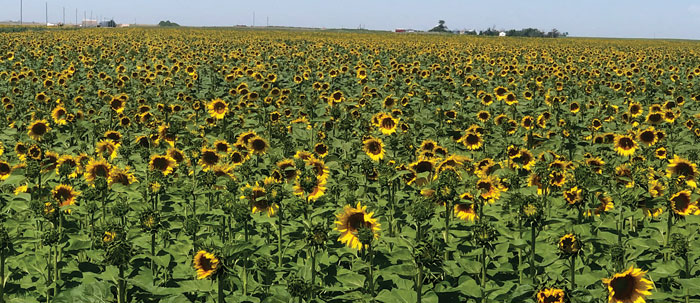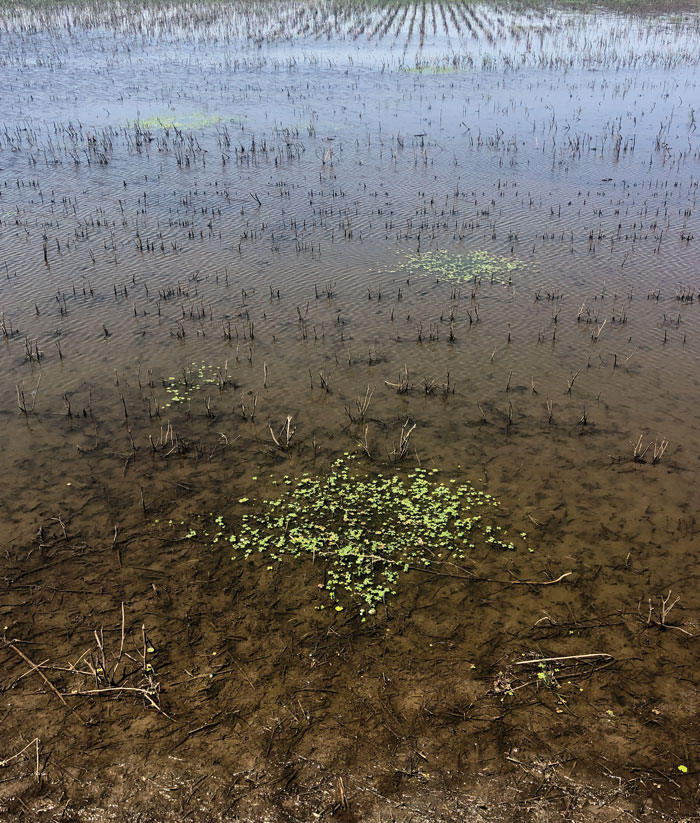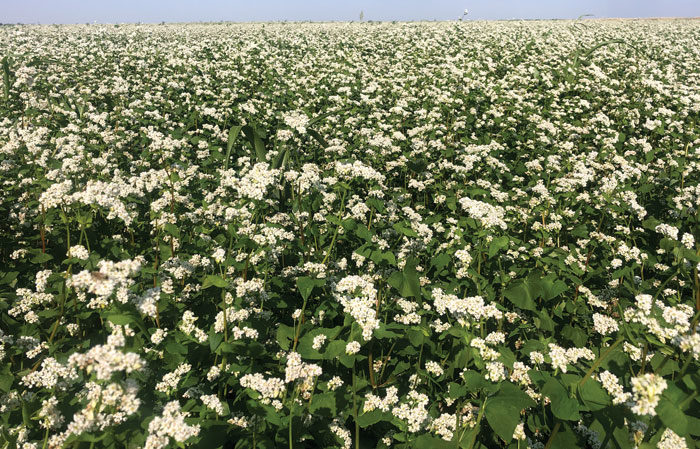Roy Pfaltzgraff III, Haxton, Colo., successfully farms where it’s “bone dry.” But with a combination of persistence and a willingness to try new things, the family operation is thriving despite the lack of moisture.
That willingness to try something outside the box was a trait Roy inherited from his father, Roy Jr. When Roy Jr. took over the farm in 1977, he didn’t hesitate to try new things, starting with sunflowers. But it was a struggle for Roy Jr. to convince his father-in-law to plant the cash crop.
Pfaltzgraff’s grandfather purchased the farm in late 1949, raising wheat and a bit of hay.
“We’re guessing our ground got broken in the late 1800s to maybe the early 1900s,” he says. “There was a lot of saved up carbon and organic matter in the soil that they farmed.”
Check The Specs...
NAME: Roy Pfaltzgraff Jr. and Roy Pfaltzgraff III
LOCATION: Haxton, Colo.
ACRES: 2,000
YEARS NO-TILLING: 37
CROPS: Sunflowers, corn, milo, proso millet, wheat, field peas, an ancient wheat called einkorn, non-GMO corn, pinto beans, black eyed peas, navy beans, black beans, buckwheat, oats, chickpeas, flax
ANNUAL PRECIPITATION: 18.5 inches
PRIMARY SOIL TYPE: Sandy clay loam
IRRIGATION: No
LIVESTOCK: No
Losing Moisture
After years of growing sunflowers with conventional tillage, Roy Jr. switched to no-till in 1984 to help retain moisture and mitigate wind erosion. He also began soil testing the same year.
Roy Jr. stopped growing sunflowers in 2006, when he started listening to those that said that sunflowers are hard on the soil and dry everything out.
“After you hear stuff enough times, even if you don’t believe it’s true, you start wondering. My dad always said that his best crop was always after sunflowers,” Pfaltzgraff says. “The only problem is that sunflowers don’t leave a lot of residue.”
The area where the Pfaltzgraff family farms in the northeast corner of Colorado has a pan evaporation rate of 72 inches per year (see sidebar to find out what pan evaporation is). Elevation and humidity play a major role in the amount of evaporation.
“If the ground isn’t covered, we’re losing moisture,” Pfaltzgraff says. “We need anything possible to stop the wind and shade the ground. During the summer, our high humidity days are 40%.”
The high evaporation rate was killing yields. So, the Pfaltzgraffs realized that when they drill seed, they need to pack in the plants to get a canopy that would protect the soil and keep the moisture from evaporating. Their area receives an average rainfall of 15.9 inches, but the timing is sometimes less than ideal.
NO-TILL TAKEAWAYS
- Elevation and humidity can influence how much water is evaporating from your soil.
- Leaving little disturbance allows crop residue to stay upright — and better able to shade the soil from evaporation and protect the soil from erosion.
- Adding crop diversity can be financially beneficial, but also has a positive impact on soil health.
“In 2021, we got 22 inches of rain, but 9 inches came in 7 hours on April 28,” Pfaltzgraff says. “We got the other 13 inches of rain over the next 45 days, and then it didn’t rain all summer.”
Although they don’t get a lot of rain, their soils are able to uptake every drop of water, and if they can hold onto it, that water will last them through the summer, Pfaltzgraff says.
The operation has many cash crops in its crop rotation, including sunflowers, corn, milo, proso millet, wheat, field peas, einkorn (an ancient wheat species), non-GMO corn, pinto beans, black eyed peas, navy beans, black beans, buckwheat, oats, chickpeas and flax. One field in particular with has had 13 different crops grown on it in 20 years — that field has one of the best soil health scores of the entire operation.
The soil on the Pfaltzgraff farm is 60% sand, 20% loam and 20% clay, with little organic matter. The average soil organic matter in their area is 1%.
“We have fields with 2.5% soil organic matter,” Pfaltzgraff says. “With that higher soil organic matter, we have better microbial activity, which means the plants are fed better and they don’t require as much moisture.”
Air Seeding Sunflowers
Pfaltzgraff began using the Haney soil test in 2017 and charts each field and the crops grown on them every year.
“We actually have the soil test results from 1984 to today,” Pfaltzgraff says. “We can see how things are changing and progressing.”

SIDE-BY-SIDE RESULTS. The Haney soil test showed that side-by-side fields had different test scores. The difference between the two fields was sunflowers being grown in the field with the higher score.
The Haney soil test confirmed that sunflowers were doing good things for their soil. They were getting soil test scores from fields that were side by side, but one field had a higher score than the other.
“When we looked through the chart of which crops had been in those fields, the field with the better score had sunflowers growing in it more recently,” Pfaltzgraff says.
With a renewed belief in the soil benefits of sunflowers, Pfaltzgraff decided to try air seeding them with a Bourgault air seeder instead of using a planter.
“I don’t like working on planters,” he says. “They have a tendency to break down no matter what.”
Air seeders typically have fluted rollers in the metering system, which crush sunflower seeds, but the Bourgault metering system features a finely pitched auger that provides accurate metering for all their crops. The Bourgault is also equipped with mid-row banders, allowing fertilizer to be placed every other seed row, and it has a single coulter with a boot.
“It’s a super simple design and handles residue like a dream,” Pfaltzgraff says. “We can go out and drill into wheat stubble, and afterward, you can’t tell it’s been drilled.”
Leaving little disturbance means that residue stays upright, which is important on the Pfaltzgraff operation.
Pfaltzgraff says his soils are so active that as soon as residue hits the soil, the soil microbes begin to consume it. “We see that with both corn stalks and sunflower stalks,” he says. “I can go into a field 2 years after sunflowers were grown in that field and not find a sunflower stalk.”
That first sunflower crop was great, but harvesting was a disaster. They tried harvesting the sunflowers with a conventional wheat head. Because all the weight is at the top with sunflowers, when the stems were cut, the sunflowers immediately fell.
“If we were driving the direction the sunflower head was leaning, it would fall into the combine head, but if we were driving in the opposite direction, the sunflowers were falling away from the combine head, and we were hoping the reel would come around in time to knock the sunflower into the head,” Pfaltzgraff says.
“At the same time, it yielded pretty darn good despite everything that fell out of the head in the field.”
The following year, Pfaltzgraff bought a sunflower head with 9-inch pans to use for harvest.
Experimental Plant Populations
Pfaltzgraff has a 5-acre field that he uses for experiments. It had been a calving field when the operation had cattle but was largely ignored after the livestock went away in 2007. “It got drilled with whatever was in the drill when somebody remembered,” he says. “My dad told me I could do anything I wanted with that field. That field has the second-best soil health score. Diversity is key to the whole thing.”
In 2017, Pfaltzgraff drilled the 5-acre field with sunflowers at 14,000 seeds per acre — the same rate they always planted sunflowers.
“We went from a 30-inch row to a 12-inch row. Inside the 30-inch row, the plants were about a foot apart. In a 12-inch row, the plants start getting multiple feet apart, because you’ve narrowed the row. It’s more space inside the row. So, we’re drilling more linear feet per acre with the same number of seeds.”
What is Pan Evaporation?
The USDA defines pan evaporation as how much water would be evaporated if a pan was kept continually full of water for an entire year.
Switching up the row spacing had a notable benefit — sunflowers grew heads that were more than 2 feet in diameter, according to Pfaltzgraff.
“They were enormous,” he says. “But that’s a sign that you don’t have enough sunflowers. We needed to increase our population.”
In 2018, Pfaltzgraff tried seeding sunflowers at a rate of 18,000 seeds per acre, but the crop was still too thin. In 2019, he planned to seed at a rate of 22,000, but a snafu changed everything.
“I mistakenly set the drill for 42,000 seeds per acre,” Pfaltzgraff says. “Our agronomist didn’t know what to do, because we had a nice and even stand, but there were tons of plants out there.”
The Pfaltzgraffs decided to let it ride and see what would happen — and they were glad they did.
They got only 6 inches of rain during that growing season and applied 20 units of N.
“When we harvested that field, it was the highest-yielding sunflower field we’ve had in the history of raising sunflowers on our farm,” he says. “We got 2,000 pounds of sunflowers per acre. It was incredible.”
Changing their practices significantly to create a tight canopy has paid off for the Pfaltzgraffs.
“Everybody is worried about getting disease in a tight canopy, but we can’t hold enough moisture to get disease growing in there,” he says.
He decided to try the same experiment with corn. Typically, their plant population is 12,000 plants per acre.
“We drilled the corn at 18,000 plants per acre,” Pfaltzgraff says. “Both my dad and the agronomist said that was too much.”
“My dad always said that his best crop was always after sunflowers. The only problem is that sunflowers don’t leave a lot of residue…”
At harvest, Pfaltzgraff used their sunflower head to harvest that corn. There was a significant learning curve in doing so.
“The problem with corn is that there’s a lot of dry matter there, and the corn heads strip off the ears,” says Pfaltzgraff. “With a wheat head, the corn plants are too tall and don’t feed well into the combine without dropping ears. We figured sunflowers are also a row crop like corn, so let’s try it.”
After harvest, the Pfaltzgraffs were talking to their crop insurance agent, and told him about their struggles with harvest.
“He said that corn beat all of our neighbors,” Pfaltzgraff says. “We raised 45-bushel corn on 6 inches of rain, and the neighbor only had 25 bushels.”
In 2022, Pfaltzgraff plans to seed corn at 27,000 plants per acre — 2½ times the typical planting population for corn in that area.
Continuous Living Crop
For many years, the Pfaltzgraffs included fallow in their rotation. “I always wondered if leaving a field fallow was gaining us anything,” Pfaltzgraff says. “Taking a third of the farm out of production ever year and giving it a chance to rest because that was the traditional way things had always been done was hard for me.”
He saw a presentation in 2017 from the University of Nebraska Extension on replacing the fallow year with field peas. Their operation had already been starting that transition, and what Pfaltzgraff learned confirmed that it was the right move.
“They showed that you could save 2 inches of rainfall by using field peas instead of leaving the soil fallow,” he says. “We had our last fallow field in 2018, and after that, we went to continuous cropping.”
One downside to the field peas was that there wasn’t much residue left in the field after harvest, and Pfaltzgraff was looking for a way to maintain a living root in the field that wouldn’t interfere with a cash crop. Dutch white clover was recommended to Pfaltzgraff because it only gets 8-10 inches tall but goes dormant when shaded by 45% under a canopy.
“A professor from Colorado State University then told me that Dutch white clover can fix 200 pounds of nitrogen per acre,” he says. “That would eliminate the need for N fertilizers.”
Pfaltzgraff interseeded Dutch white clover for the first time in the summer of 2019 to see if it could be a continuous living crop. The Dutch white clover was drilled into two different fields — one with flax and the other with sunflowers at a rate of a ½ pound per acre. In those initial fields, the clover has continued to survive and there has been a continuous living root for 33 months.
Cash crop yields for the flax and sunflowers were not affected by the Dutch white clover, according to Pfaltzgraff.
“We see the weeds act differently where the clover has established a good stand,” he says. “The weeds really don’t like to grow. We’d been having problems with Palmer amaranth, but Palmer amaranth and clover just don’t get along.”
The mycorrhizal fungi in the soil don’t get much from the Palmer amaranth, but does from the Dutch white clover, so the mycorrhizae feed into the clover and not the Palmer amaranth, Pfaltzgraff says.
Switching to continuous cropping was the beginning of a significant change in what was happening in their soils and the farm’s economics. A few years ago, the Pfaltzgraffs had a serious discussion about whether the farm was in a financial condition to continue.

NOT LILYPADS. The sunflower field where Dutch white clover was interseeded ended up having standing water after a major rainstorm. The Dutch white clover still came up through the water.
“Breaking even and hoping to get one good crop every 5 years was a really challenging and stressful way to live,” Pfaltzgraff says. “We were very concerned about losing the farm. You don’t want to lose what your entire family has worked on for generations.”
The Pfaltzgraffs have discovered that there are a lot more markets out there for cash crops than they had been aware of.
“When we first started doing continuous cropping, my dad said that I could grow whatever I want, as long as I had a market before it’s planted,” Pfaltzgraff says. “The local CHS coop takes wheat, sunflowers, field peas, proso millet, corn, milo and oats. So, they actually take a lot.”
Pfaltzgraff wanted to raise buckwheat for the soil health benefits and because it frees up phosphorus in the soil, which the soil on their farm lacks.
“I talked to a friend about marketing our buckwheat, and he knew of a gluten-free malting company that was looking for buckwheat,” Pfaltzgraff says. “The first year we sold to them, they forecasted that they’d need 25,000 pounds, and we sold them 35,000 pounds. The forecast for next year is a single client that wants more than 250,000 pounds.”
Their buckwheat goes to 70 different gluten-free breweries in the U.S. and 7 other countries. The same malting company also takes their millet and oats after they’ve been cleaned.
“One year, we had some extra buckwheat, and I started poking around on the internet, and found Minn-Dak, a buckwheat company in Grand Forks, N.D., that processes buckwheat and sends it to Japan for soba noodles,” Pfaltzgraff says. “They were bidding 23 cents a pound and asked me to send a sample.”
Three days after sending a sample to Minn-Dak, they called Pfaltzgraff and told him they’d pay 25 cents a pound and the trucks would come to the farm to pick up the buckwheat.
“Buckwheat usually runs around 12% protein, but ours was more than 18%,” he says. “The extra stress on the plant is what produces protein.”
He attributes continuous cropping with allowing the operation to add diversity and more efficiency.
“It used to be we had to get 700 acres of wheat in the ground in a week, and we had a week to get it harvested,” Pfaltzgraff says. “Now, with 80 acres of this and 160 acres of that, we can do it ourselves. So, our equipment is actually moving more days out of the year.”
This increase in efficiency has allowed the Pfaltzgraffs to cut $40,000 in custom harvesting. The operation has tripled its revenue, although expenses have doubled.
“Last year, our cash flows were shocking,” he says. “The first time the banker saw the new cash flow projections with all the different crops, he didn’t want to loan us the money. But then, when we showed him the documentation of where everything was going to be sold, the price we were going to get and the average yield we expected, they went along with it.”
The operation has been able to make a major capital investment in new equipment, thanks to the increased cash flow.
“Our accountant said that we actually recapitalized the farm in a single year,” Pfaltzgraff says. “He said you see that in big business, but not in agriculture.”
The Pfaltzgraffs are even going to have to start paying taxes once depreciation runs out on their new equipment.
Grain inventory also looks a bit different these days in their operation. Previously, inventory would be at zero, because all the crops would be sold to the elevator. Now, the Pfaltzgraffs roll over a couple hundred thousand dollars’ worth of inventory.
“With these specialty markets, they don’t necessarily want all of the crop at once,” he says. “For example, the company we sell buckwheat to wants 30,000 pounds at a time over 6-9 months. It’s a learning curve for both us and the banker.”








Post a comment
Report Abusive Comment